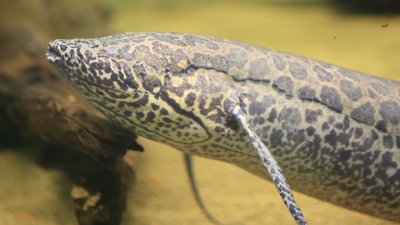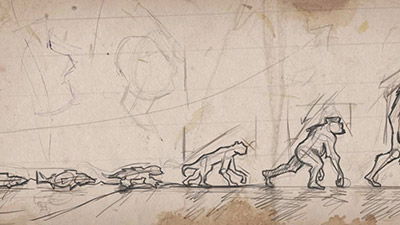Another Missing Link
Is it time already for the announcement of yet another alleged “missing link”? Apparently so!
News Source
The nickname this time might be “Sediba,” short for the new designation Australopithecus sediba, although in this case there are actually two fossils. Scientists judged one to be a female adult and the other a younger male, perhaps mother and son. Two more individuals are buried close by and are currently being excavated. The bones were found near Johannesburg in South Africa.
The remains were discovered in a pit that was once part of a cave. BBC News reports that “[i]t is likely their bodies were then swept into an underground lake or pool, perhaps during a rainstorm” and later adds:
Their bones were laid down with the remains of other dead animals, including a sabre-toothed cat, antelope, mice, and rabbits. The fact that none of the bodies appear to have been scavenged indicates that all died suddenly and were entombed rapidly.
Commenting on the burial itself, team member Paul Dirks of James Cook University explained, “We think that there must have been some sort of calamity taking place at the time that caused all of these fossils to come down together into the cave where they got trapped and ultimately buried.”
The scientists disagree, however, on just what the individuals were. Despite their inclusion in genus Australopithecus (home to well-known “ape-man” Lucy), scientists such as Colin Groves of Australian National University believe the bones should be classified as Homo instead. Adding to the confusion is that evolutionists have dated the bones as younger than remains that have already been labeled Homo—which, were the dating right, would imply that the individuals discovered could not have been human ancestors.
Lead scientist Lee Berger of the University of the Witwatersrand offers what may be some clarification, however. First, he notes that the scientists have “pointed to certain similarities with early Homo, seeming even to admit that the predominance of its features were with Homo, only the small cranial capacity being really an Australopithecine feature.” In that regard, Berger points out the similarity to the Indonesian “hobbit” species, Homo floresiensis. We’ve argued before that the hobbit was likely fully human, and Berger’s comment suggests the Australopithecus sediba fossils may in fact be misclassified Homo individuals who were fully human.
Their interpretation may be challenged dramatically by other evolutionists as time passes.
Berger also reminds us that that portion of the fossil record “is one of the most poorly represented in the entire early hominid fossil record . . . a very small, very fragmentary record.” Of course, this portion coincides exactly with the time when apes were supposed to have evolved into men!
Creationists must be cautious interpreting news like this. For one thing, the bones have been examined by only one group of scientists, and their interpretation may be challenged dramatically by other evolutionists as time passes. (Recall the “missing link” hype—which quickly evaporated—over Ida.) Creationists, in particular, do not routinely have access to such finds until much time has passed, preventing an investigation based on the biblical perspective. Also, it is impossible for us to ever completely determine the full range of anatomical features in the original, pre-Flood human population. While some cases are fairly clear (e.g., Neanderthals), others are difficult considering the vague evidence that remains. What we must remember is that God created humans distinct from all animals: fashioning us in His image, not fashioning us from ape-like creatures. Despite the variation in size, shape, color, etc., (even if only considering the present), we are all equally human.
Further Reading
- Did Humans Really Evolve from Apelike Creatures?
- The Origin of Humans
- Get Answers: Human Evolution, Fossils
For More Information: Get Answers
Remember, if you see a news story that might merit some attention, let us know about it! (Note: if the story originates from the Associated Press, FOX News, MSNBC, the New York Times, or another major national media outlet, we will most likely have already heard about it.) And thanks to all of our readers who have submitted great news tips to us. If you didn’t catch all the latest News to Know, why not take a look to see what you’ve missed?
(Please note that links will take you directly to the source. Answers in Genesis is not responsible for content on the websites to which we refer. For more information, please see our Privacy Policy.)

Answers in Genesis is an apologetics ministry, dedicated to helping Christians defend their faith and proclaim the good news of Jesus Christ.
- Customer Service 800.778.3390
- Available Monday–Friday | 9 AM–5 PM ET
- © 2026 Answers in Genesis




